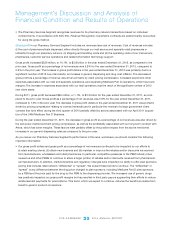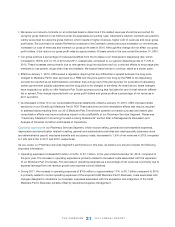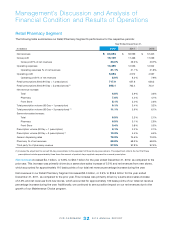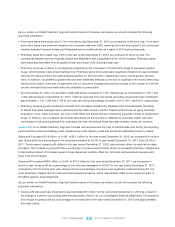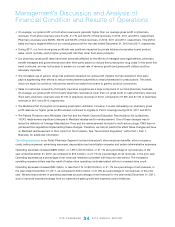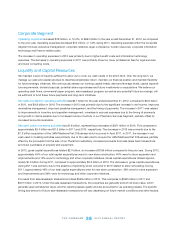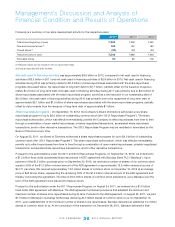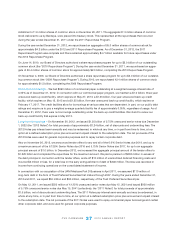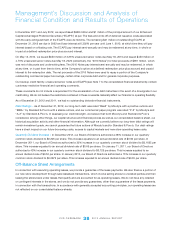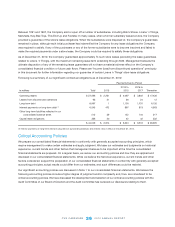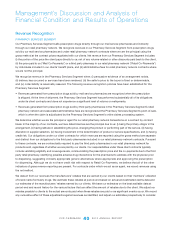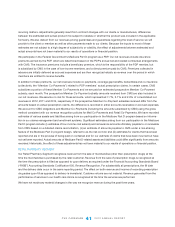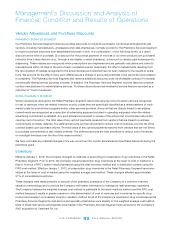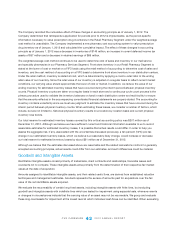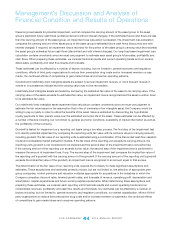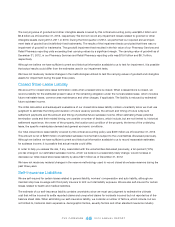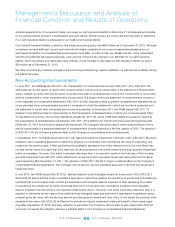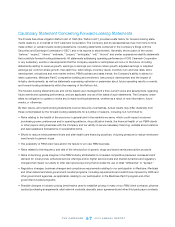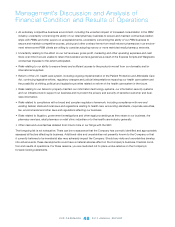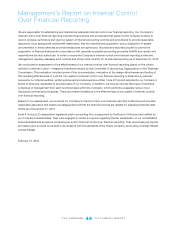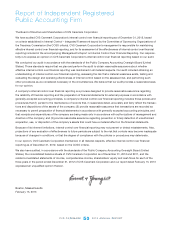CVS 2012 Annual Report Download - page 42
Download and view the complete annual report
Please find page 42 of the 2012 CVS annual report below. You can navigate through the pages in the report by either clicking on the pages listed below, or by using the keyword search tool below to find specific information within the annual report.Management’s Discussion and Analysis of
Financial Condition and Results of Operations
CVS CAREMARK 2012 ANNUAL REPORT
40
Revenue Recognition
PHARMACY SERVICES SEGMENT
Our Pharmacy Services Segment sells prescription drugs directly through our mail service pharmacies and indirectly
through our retail pharmacy network. We recognize revenues in our Pharmacy Services Segment from prescription drugs
sold by our mail service pharmacies and under retail pharmacy network contracts where we are the principal using the
gross method at the contract prices negotiated with our clients. Net revenue from our Pharmacy Services Segment includes:
(i) the portion of the price the client pays directly to us, net of any volume-related or other discounts paid back to the client,
(ii) the price paid to us (“Mail Co-Payments”) or a third party pharmacy in our retail pharmacy network (“Retail Co-Payments”)
by individuals included in our clients’ benefit plans, and (iii) administrative fees for retail pharmacy network contracts where
we are not the principal.
We recognize revenue in the Pharmacy Services Segment when: (i) persuasive evidence of an arrangement exists,
(ii) delivery has occurred or services have been rendered, (iii) the seller’s price to the buyer is fixed or determinable,
and (iv) collectability is reasonably assured. The following revenue recognition policies have been established for the
Pharmacy Services Segment:
• Revenuesgeneratedfromprescriptiondrugssoldbymailservicepharmaciesarerecognizedwhentheprescription
is shipped. At the time of shipment, the Pharmacy Services Segment has performed substantially all of its obligations
under its client contracts and does not experience a significant level of returns or reshipments.
• RevenuesgeneratedfromprescriptiondrugssoldbythirdpartypharmaciesinthePharmacyServicesSegment’sretail
pharmacy network and associated administrative fees are recognized at the Pharmacy Services Segment’s point-of-sale,
which is when the claim is adjudicated by the Pharmacy Services Segment’s online claims processing system.
We determine whether we are the principal or agent for our retail pharmacy network transactions on a contract by contract
basis. In the majority of our contracts, we have determined we are the principal due to us: (i) being the primary obligor in the
arrangement, (ii) having latitude in establishing the price, changing the product or performing part of the service, (iii) having
discretion in supplier selection, (iv) having involvement in the determination of product or service specifications, and (v) having
credit risk. Our obligations under our client contracts for which revenues are reported using the gross method are separate
and distinct from our obligations to the third party pharmacies included in our retail pharmacy network contracts. Pursuant
to these contracts, we are contractually required to pay the third party pharmacies in our retail pharmacy network for
products sold, regardless of whether we are paid by our clients. Our responsibilities under these client contracts typically
include validating eligibility and coverage levels, communicating the prescription price and the co-payments due to the third
party retail pharmacy, identifying possible adverse drug interactions for the pharmacist to address with the physician prior
to dispensing, suggesting clinically appropriate generic alternatives where appropriate and approving the prescription
for dispensing. Although we do not have credit risk with respect to Retail Co-Payments, we believe that all of the other
indicators of gross revenue reporting are present. For contracts under which we act as an agent, we record revenues using
the net method.
We deduct from our revenues the manufacturers’ rebates that are earned by our clients based on their members’ utilization
of brand-name formulary drugs. We estimate these rebates at period-end based on actual and estimated claims data and
our estimates of the manufacturers’ rebates earned by our clients. We base our estimates on the best available data at
period-end and recent history for the various factors that can affect the amount of rebates due to the client. We adjust our
rebates payable to clients to the actual amounts paid when these rebates are paid or as significant events occur. We record
any cumulative effect of these adjustments against revenues as identified, and adjust our estimates prospectively to consider


